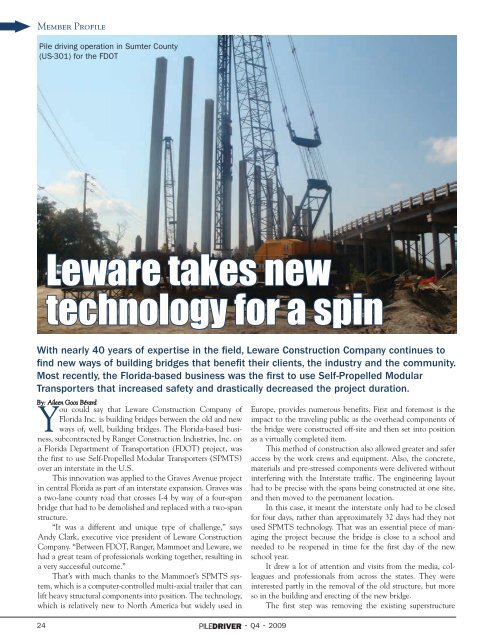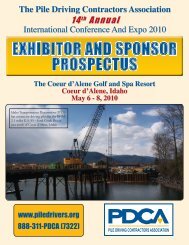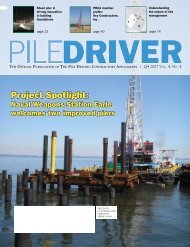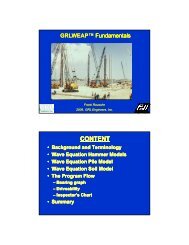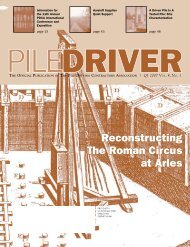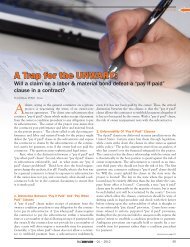Full Issue (17 MB) - Pile Driving Contractors Association
Full Issue (17 MB) - Pile Driving Contractors Association
Full Issue (17 MB) - Pile Driving Contractors Association
Create successful ePaper yourself
Turn your PDF publications into a flip-book with our unique Google optimized e-Paper software.
Member Profile<br />
<strong>Pile</strong> driving operation in Sumter County<br />
(US-301) for the FDOT<br />
Leware takes new<br />
technology for a spin<br />
With nearly 40 years of expertise in the field, Leware Construction Company continues to<br />
find new ways of building bridges that benefit their clients, the industry and the community.<br />
Most recently, the Florida-based business was the first to use Self-Propelled Modular<br />
Transporters that increased safety and drastically decreased the project duration.<br />
By: Aileen Goos Bérard<br />
You could say that Leware Construction Company of<br />
Florida Inc. is building bridges between the old and new<br />
ways of, well, building bridges. The Florida-based business,<br />
subcontracted by Ranger Construction Industries, Inc. on<br />
a Florida Department of Transportation (FDOT) project, was<br />
the first to use Self-Propelled Modular Transporters (SPMTS)<br />
over an interstate in the U.S.<br />
This innovation was applied to the Graves Avenue project<br />
in central Florida as part of an interstate expansion. Graves was<br />
a two-lane county road that crosses I-4 by way of a four-span<br />
bridge that had to be demolished and replaced with a two-span<br />
structure.<br />
“It was a different and unique type of challenge,” says<br />
Andy Clark, executive vice president of Leware Construction<br />
Company. “Between FDOT, Ranger, Mammoet and Leware, we<br />
had a great team of professionals working together, resulting in<br />
a very successful outcome.”<br />
That’s with much thanks to the Mammoet’s SPMTS system,<br />
which is a computer-controlled multi-axial trailer that can<br />
lift heavy structural components into position. The technology,<br />
which is relatively new to North America but widely used in<br />
24 • Q4 • 2009<br />
Europe, provides numerous benefits. First and foremost is the<br />
impact to the traveling public as the overhead components of<br />
the bridge were constructed off-site and then set into position<br />
as a virtually completed item.<br />
This method of construction also allowed greater and safer<br />
access by the work crews and equipment. Also, the concrete,<br />
materials and pre-stressed components were delivered without<br />
interfering with the Interstate traffic. The engineering layout<br />
had to be precise with the spans being constructed at one site,<br />
and then moved to the permanent location.<br />
In this case, it meant the interstate only had to be closed<br />
for four days, rather than approximately 32 days had they not<br />
used SPMTS technology. That was an essential piece of managing<br />
the project because the bridge is close to a school and<br />
needed to be reopened in time for the first day of the new<br />
school year.<br />
It drew a lot of attention and visits from the media, colleagues<br />
and professionals from across the states. They were<br />
interested partly in the removal of the old structure, but more<br />
so in the building and erecting of the new bridge.<br />
The first step was removing the existing superstructure


